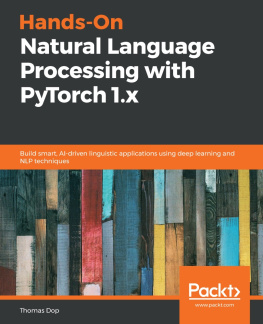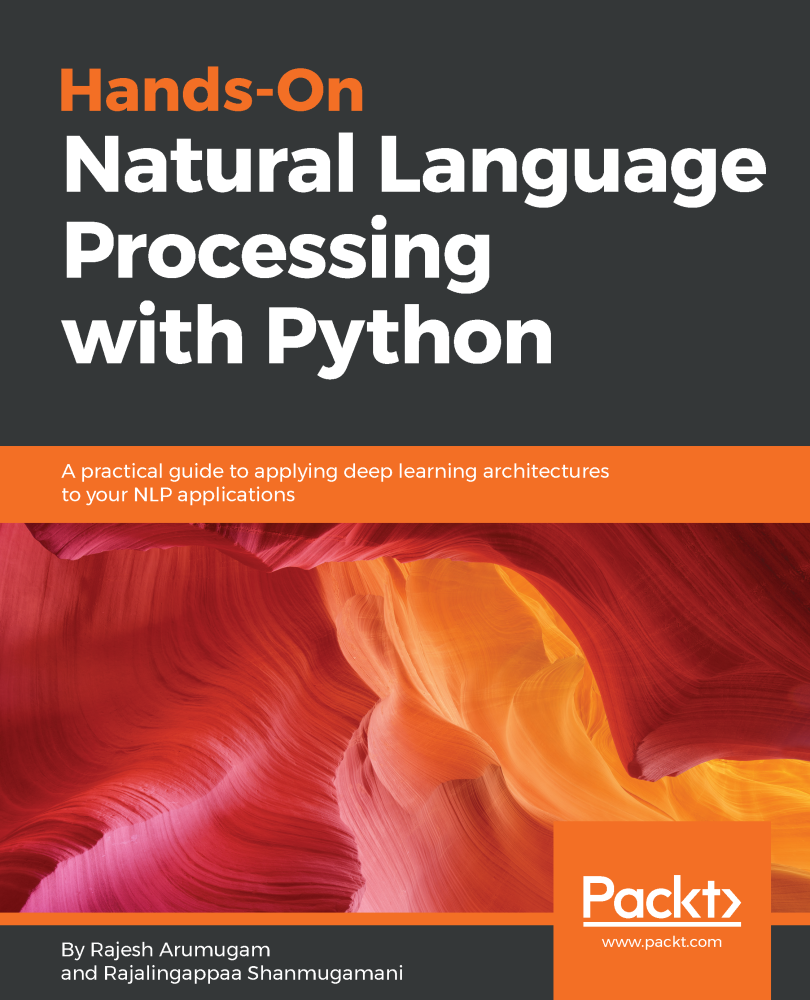Did you know that Packt offers eBook versions of every book published, with PDF and ePub files available? You can upgrade to the eBook version at www.PacktPub.com and as a print book customer, you are entitled to a discount on the eBook copy. Get in touch with us at service@packtpub.com for more details.
At www.PacktPub.com , you can also read a collection of free technical articles, sign up for a range of free newsletters, and receive exclusive discounts and offers on Packt books and eBooks.
Foreword
Intelligent digital assistants in form of voice transcription, machine translation, conversational agents, and sentiment analysis are ubiquitously applied across various domains to facilitate human-computer interactions. Chatbot's are becoming an integrated part of any website; while virtual assistants are gaining more popularity in homes and office spaces. Consequently, given numerous existing resources that contain these topics under the notion of natural language processing (NLP), a contribution that covers a comprehensive guide to the fundamentals and the state-of-the-art, and on top of that includes practical examples with most popular frameworks and tool kits, is a rare find.
When I was first asked to write the foreword for this book, I was very delighted to convey the level of passion that drove the authors to write it, and yet was uncertain on how to best present an excellent source of up-to-date knowledge and a practical handbook of machine learning (ML) for NLP that truly stands out from the crowd.
The leading authors' reputation in ML needs no further explanation. With both equipped with academic education in world-class universities and many years of leadership in ML development, Rajesh and Rajalingappa's qualification to lead the authorship of this book is confirmed. I have come to know them not only as knowledgeable individuals but also as passionate educators who convey the most sophisticated concepts in the simplest words. Raja's passion to help start-ups get off the ground and to offer his expertise to young companies with an open heart is admirable. I'm sure that, even as readers of this book, you can approach him for questions and be sure of a convincing response.
The book itself is very well organized and written to serve the purpose. From concrete examples to explain the fundamentals to code snippets for guiding readers with different levels of deep learning backgrounds, the chapters are structured to retain full attention of the reader all throughout. You will discover an exciting combination of the most popular techniques and state-of-the-art approaches to text processing and classification.
By reading this book, you can expect to learn how to perform common NLP tasks, such as preprocessing and exploratory analysis of text using the Python's Natural Language Toolkit. You will understand deep neural networks, Google's TensorFlow framework, and the building blocks of recurrent neural networks (RNNs), including Long Short-Term Memory. And you will grasp the notion of word embeddings to allow for semantics in context.
Having taught the basics, the book further takes you through the development of architectures and deep neural network models for a variety of applications, including text classification, text generation and summarization, question-answering, language translation, speech recognition, and text-to-speech.
The book concludes by presenting various methods to deploy a trained model for NLP tasks, on a variety of platforms. By the end of your experience with the book, you will have learned the data science paradigm in NLP and can hopefully deploy deep learning models in commercial applications in a production environment as the authors envisioned.
Maryam Azh, PhD
Founder of Overlay Technologies
Contributors
About the authors
Rajesh Arumugam is an ML developer at SAP, Singapore. Previously, he developed ML solutions for smart city development in areas such as passenger flow analysis in public transit systems and optimization of energy consumption in buildings when working with Centre for Social Innovation at Hitachi Asia, Singapore. He has published papers in conferences and has pending patents in storage and ML. He holds a PhD in computer engineering from Nanyang Technological University, Singapore.







